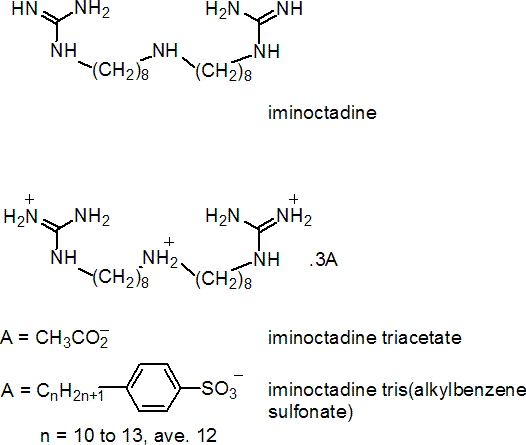|
iminoctadine
Fungicide
FRAC M7; multi-site: guanidine

NOMENCLATURE
iminoctadine
Common name iminoctadine (BSI, draft E-ISO, (f) draft F-ISO); guazatine* (see notes under Composition); guanoctine* (see notes under Composition)
IUPAC name 1,1'-iminodi(octamethylene)diguanidine; bis(8-guanidino-octyl)amine
Chemical Abstracts name N,N'''-(iminodi-8,1-octanediyl)bisguanidine
CAS RN [13516-27-3] EEC no. 236-855-3
iminoctadine triacetate
IUPAC name 1,1'-iminodi(octamethylene)diguanidinium triacetate
CAS RN [57520-17-9]; [39202-40-9] deleted number Development codes DF 125 (Dainippon)
iminoctadine tris(albesilate)
IUPAC name 1,1'-iminodi(octamethylene)diguanidinium tris(alkylbenzenesulfonate)
Chemical Abstracts name N,N'''-(iminodi-8,1-octanediyl)bisguanidinium tris(dodecylbenzenesulfonate)
CAS RN [169202-06-6] Development codes DF-250 (Dainippon)
PHYSICAL CHEMISTRY
iminoctadine
Composition The name guazatine* was applied to this structure (BSI, E-ISO, (f) F-ISO) until 1986 (BSI used the name guanoctine* from 1970-1972), but the name now applies to a reaction mixture (see entry under guazatine). Mol. wt. 355.6 M.f. C18H41N7 pKa Strong base
iminoctadine triacetate
Mol. wt. 535.7 M.f. C24H53N7O6 Form Colourless crystals. M.p. 143.0-144.2 ºC V.p. <0.4 mPa (23 ºC) KOW logP = -2.33 (pH 7) (for a.i.) Solubility In water 764 g/l. In ethanol 117, methanol 777 (both in g/l, 25 °C).
iminoctadine tris(albesilate)
Composition The counterion is a mixture of C10 to C13 alkylbenzenesulfonates; weight average corresponds to C12. Mol. wt. 1335 (ave.) M.f. C72H131N7O9S3 (ave.) Form Pale brown, waxy solid (tech.). M.p. 92-96 °C V.p. <1.6 ´ 10-1 mPa (60 °C) KOW logP = 2.05 (pH 7) Solubility In water 6 mg/l (20 °C). In methanol 5660, ethanol 3280, isopropanol 1800, benzene 0.22, acetone 0.55 (all in g/l); insoluble in acetonitrile, dichloromethane, n-hexane, xylene, carbon disulfide and ethyl acetate (20 °C). Stability Stable in alkaline or acidic aqueous media at room temperature.
COMMERCIALISATION
iminoctadine
History Fungicidal properties of its salts were described originally by W. S. Catling et al. (Congr. Plant Pathol., 1st, 1968, p. 27 (Abstr.)), with details given later (Jpn. Pestic. Inf., 1986, No. 49, p. 7).
iminoctadine triacetate
History Introduced by Evans Medical Ltd, developed by Murphy Chemical Ltd (now part of Dow AgroSciences) and introduced in Japan (1983) by Dainippon Ink and Chemicals, Inc. Manufacturers Dainippon
iminoctadine tris(albesilate)
History Developed by Dainippon Ink & Chemicals, Inc. and reported by E. Adachi and K. Nakajima (Agrochem. Japan, 66, 18 (1995)). First registered in Japan in 1994. Patents US 4659739; EP 155509 Manufacturers Dainippon
APPLICATIONS
Biochemistry Affects the functions of the fungal cell membrane and lipid biosynthesis, at a site different from that of the steroid demethylation inhibiting fungicides. Mode of action Protective fungicide.
iminoctadine triacetate
Uses Fungicide used on cereals as seed treatment (at 3-5 ml/kg seed) or foliar spray against Fusarium, Septoria, Helminthosporium gramineum and Tilletia spp.; on citrus pre-harvest against Alternaria and Penicillium spp.; on apples as a dormant spray (at 0.5-1 kg/ha) against Valsa ceratosperma, or foliar spray (at 0.6-0.9 kg/ha) against Alternaria, Botryosphaeria, Gloeodes or Zygophiala spp. Selected products: 'Befran' (Dainippon); mixtures: 'Befran-Seed' (+ ipconazole) (Kureha, Dainippon)
iminoctadine tris(albesilate)
Uses Fungicide used on fruit, vegetables (at 0.25-0.5 kg/ha), and field crops (at 0.5-1.5 kg/ha) against a wide range of fungal pathogens: scab (Venturia spp.) on apples and pears; scab (Cladosporium spp.) on peaches and Japanese apricots; grey mould on citrus, persimmons, onions, cucumbers, tomatoes and lettuces; powdery mildew on persimmons, water melons, cucumbers and strawberries; anthracnose (Colletotrichum spp.) on water melons, tea and kidney beans; Sclerotinia disease on water melons and lettuces; Alternaria blotch, ring rot, blotch, fly speck and sooty blotch on apples; black spot and Physalospora canker on pears; brown rot and Phomopsis rot on peaches; anthracnose (Gloeosporium kaki) and angular leaf spot on persimmons; Botryosphaeria disease on kiwifruit; grey leaf spot on loquats; gummy stem blight on water melons; grey blight and shoot blight (Pestalotia spp.) on tea; stem blight and Stemphylium disease on asparagus; leaf blight on carrots; leaf mould on tomatoes; scab (Fusarium roseum) on wheat; early blight on potatoes; Ramularia leaf spot on sugar beet. Formulation types WP. Selected products: 'Bellkute' (Dainippon)
OTHER PRODUCTS
iminoctadine tris(albesilate)
Mixtures: 'Daipower' (+ captan) (Dainippon); 'Dyemazine' (+ fenhexamid) (Japan) (Bayer CropScience); 'Polybelin' (+ polyoxin B) (Kumiai)
ANALYSIS
Product analysis by hplc. Residues determined by glc after conversion to a pyrimidine derivative or by hplc (Y. Mori et al., Nihon Noyaku Gakkaishi, 1982, 7, 53).
MAMMALIAN TOXICOLOGY
iminoctadine
Toxicity class WHO (a.i.) II (classification assigned to iminoctadine on the basis of data for the acetate) EC classification Xn; R21/22| Xi; R36/38| N; R50, R53
iminoctadine triacetate
Oral Acute oral LD50 for rats c. 300, mice 400 mg/kg. Skin and eye Acute percutaneous LD50 for rats c. 1500 mg/kg. A mild skin and mild eye irritant, but not a skin sensitiser. Inhalation LC50 (4 h) for rats 0.073 mg/l air (for 25% liquid formulation). NOEL 0.356 mg/kg daily. ADI 0.0023 mg/kg b.w. (as iminoctadine) Other Not embryotoxic at 8 mg/kg. Not mutagenic in Ames and Rec assays.
iminoctadine tris(albesilate)
Oral Acute oral LD50 for male and female rats 1400, male mice 4300, female mice 3200 mg/kg. Skin and eye Acute percutaneous LD50 for male and female rats >2000 mg/kg. Slight eye and skin irritation (rabbits). Not a skin sensitiser (guinea pigs). Inhalation LC50 for rats 1.0 mg/l. NOEL For rats 0.9 mg/kg daily. ADI 0.0023 mg/kg b.w. (as iminoctadine) Other Negative in Ames, Rec and chromosome aberration tests.
ECOTOXICOLOGY
iminoctadine triacetate
Birds Acute oral LD50 for mallard ducks 985 mg/kg. Fish LC50 (96 h) for carp 200, rainbow trout 36 mg/l. Daphnia LC50 (48 h) 2.1 mg/l. Bees LD50 (oral and contact) >0.1 mg/bee.
iminoctadine tris(albesilate)
Birds Acute oral LD50 for Japanese quail 1827 mg/kg. Fish LC50 (48 h) for rainbow trout 4.5 mg/l, for carp 14.4 ppm. Daphnia LC50 (3 h) for D. carinata >100 ppm. Worms LC50 for earthworms >1000 ppm.
ENVIRONMENTAL FATE
iminoctadine triacetate
Soil/Environment Soil DT50 90 d (diluvial sandy loam), 122 d (volcanic ash loamy upland soil), 75 d (colluvial clayey loamy upland soil), 28 d (volcanic ash loamy upland soil).
iminoctadine tris(albesilate)
Soil/Environment Koc 214 453.
|